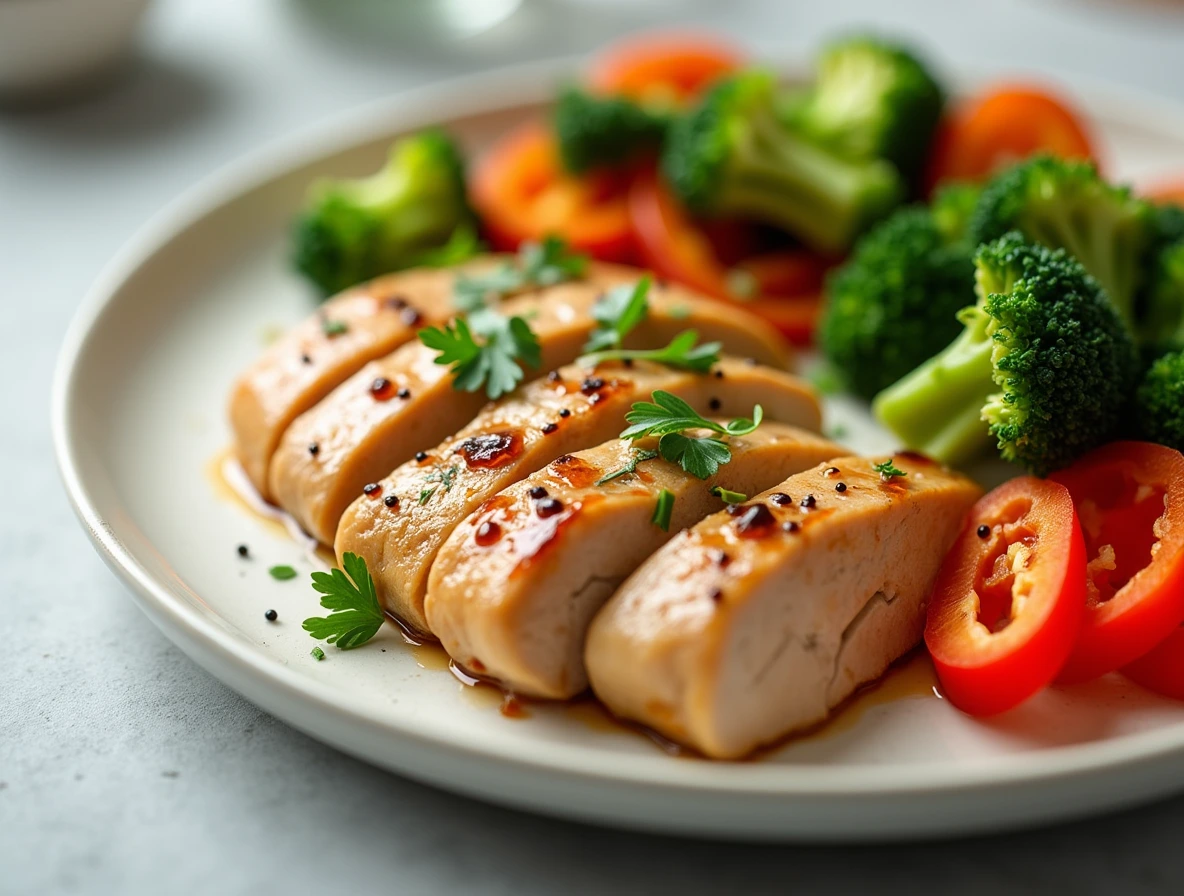A steam chicken recipe is one of the healthiest and most flavorful ways to prepare chicken. Unlike other cooking methods, steaming preserves the natural flavors while keeping the meat moist and tender. It locks in essential nutrients, making it an ideal cooking method for anyone who wants to prepare a wholesome and delicious meal. Whether you’re preparing a quick weeknight dinner or a special dish for a gathering, steamed chicken is an excellent choice that is both nutritious and satisfying.
In this article, we’ll walk you through why steaming is such an advantageous cooking method, what equipment and ingredients you need, and how to create the perfect steamed chicken meal. Additionally, we’ll explore various variations of steam chicken recipes to suit different tastes, along with tips and FAQs to help you master the art of steaming chicken.
Why Steaming is the Healthiest Way to Cook Chicken
Steaming chicken offers several significant advantages over traditional cooking methods, making it a go-to method for those focused on healthy eating and preserving the flavor of their meals. Here are the key benefits of steaming chicken:
1. Moisture Retention
Unlike grilling, frying, or roasting, which can often dry out the chicken, steaming locks in moisture. The process of steaming allows the chicken to cook gently in its own steam, resulting in a juicy and tender outcome. This makes steamed chicken ideal for dishes where you want to maintain a soft, moist texture without the risk of overcooking.
2. Low-Fat Cooking
Another advantage of steaming is that it requires no oil or fats, making it one of the healthiest cooking methods available. Since no added oils are necessary, steaming helps reduce the overall fat content of your meal, making it a perfect choice for those watching their calorie intake or maintaining a low-fat diet.
3. Nutrient Preservation
Steaming preserves more nutrients in the chicken compared to other cooking methods, like grilling or frying, which can lead to significant nutrient loss. Steamed chicken retains its essential vitamins, minerals, and proteins, ensuring that you get the most nutritional benefit from your meal. The gentle cooking process helps to keep nutrients intact, making it a wholesome choice for anyone looking to eat cleaner and healthier.
4. Retains Natural Flavors
Steaming allows the chicken to retain its natural flavor profile, which is often lost when cooking methods like frying or roasting are used. The meat absorbs the subtle flavors of any herbs, spices, and marinades you use, creating a dish that is both flavorful and wholesome.
5. Tender and Delicate Texture
The moist environment created by steaming helps to soften the chicken, making it extremely tender. This is especially important if you’re cooking tougher cuts of chicken, such as chicken breasts, which can become dry and chewy when overcooked using other methods. Steaming ensures that your chicken remains tender, making every bite a delight.

What You Need for a Steamed Chicken Recipe
Making the perfect steamed chicken requires a few basic tools and ingredients. Below is a checklist to ensure you have everything you need before starting:
Equipment:
- Steamer: You can use various types of steamers for steaming chicken, including bamboo steamers, electric steamers, or even a makeshift steamer made with a pot and a rack. The choice of steamer depends on what you have available and how much chicken you plan to cook.
- Meat Thermometer: A meat thermometer is essential to check the internal temperature of the chicken to ensure it has reached the recommended 165°F (75°C). This guarantees that the chicken is fully cooked and safe to eat.
- Pot or Wok: If you’re using a stovetop method, a large pot or wok with a lid works well for steaming. Ensure the pot is large enough to fit the chicken and allow steam to circulate around it.
Ingredients:
- Chicken: Choose chicken breasts, thighs, or even a whole chicken. For the best flavor and quality, opt for organic or free-range chicken if possible. Fresh chicken is always recommended for the best taste.
- Herbs and Spices: Fresh garlic, ginger, and herbs like cilantro or parsley are often used in steamed chicken recipes to enhance flavor. You can also use spices like pepper or turmeric to add an extra layer of flavor.
- Seasonings: Low-sodium soy sauce, sesame oil, fish sauce, or oyster sauce are commonly used to season steamed chicken without adding unnecessary calories or fat. These ingredients give the chicken a savory, umami flavor that pairs perfectly with its delicate texture.
Step-by-Step Guide to Steaming Chicken
Step 1: Prepare the Chicken
Before you start steaming, make sure the chicken is prepared correctly:
- Trim the Chicken: Remove any skin or excess fat from the chicken if desired. Trimming the fat helps to reduce calories and makes the final dish lighter.
- Marinate (Optional): For extra flavor, marinate the chicken before steaming. A simple marinade using soy sauce, garlic, ginger, and a bit of sesame oil can enhance the flavor of the chicken. For best results, marinate the chicken for at least 30 minutes (or up to overnight in the fridge) to allow the flavors to seep into the meat.
Step 2: Set Up the Steamer
Now it’s time to set up your steamer:
- Add Water to the Steamer Pot: Fill your steamer pot with water, but make sure the water level is below the steamer basket or rack so that the chicken isn’t submerged. The idea is to use steam, not boiling water, to cook the chicken.
- Bring the Water to a Boil: Place the pot over medium heat and bring the water to a boil.
- Prepare the Steamer Basket: If you are using a bamboo steamer, line it with parchment paper to prevent the chicken from sticking. You can also use a regular metal steaming rack or basket.
Step 3: Steam the Chicken
Once your steamer is set up and the water is boiling, it’s time to place the chicken in the steamer:
- Arrange the Chicken: Place the chicken pieces in the steamer basket in a single layer, making sure they are not overcrowded. This allows the steam to circulate evenly around the chicken, ensuring it cooks thoroughly.
- Cover and Steam: Cover the steamer and let the chicken cook. Steaming times will vary depending on the size and type of chicken:
- Chicken Breasts or Thighs: 20-25 minutes.
- Whole Chicken: 45-60 minutes.
Always use a meat thermometer to check that the internal temperature of the chicken has reached 165°F (75°C).
Step 4: Finishing Touches
Once the chicken is done, remove it from the steamer and let it rest for a few minutes. This allows the juices to redistribute, making the chicken even more tender and flavorful. Serve your steamed chicken with steamed vegetables, brown rice, or quinoa for a balanced and nutritious meal.
Variations of Steam Chicken Recipes
Steamed chicken is incredibly versatile, and you can adapt the recipe to suit different tastes and cuisines. Here are a few popular variations:
1. Steam Chicken with Garlic and Ginger
This classic recipe uses fresh garlic and ginger to infuse the chicken with aromatic, savory flavors. The ginger adds a slight spiciness, while the garlic brings a rich depth of flavor.
2. Lemongrass Steam Chicken
For a Vietnamese-inspired dish, use lemongrass, fish sauce, and garlic. The lemongrass adds a refreshing, tangy aroma, while the fish sauce contributes a salty, umami depth to the dish.
3. Spicy Steam Chicken
If you enjoy spicy food, add chili peppers, hot sauce, or chili paste to the marinade. This variation gives the chicken a fiery kick, making it perfect for those who love heat.
4. Herb-Infused Steam Chicken
For a lighter, fresher taste, try infusing the chicken with herbs such as cilantro, parsley, or thyme. The herbs will subtly enhance the chicken’s natural flavors, making it a refreshing option for spring and summer meals.
FAQs About Steam Chicken Recipe
How Long Does it Take to Steam Chicken?
The steaming time depends on the cut of chicken:
- Chicken Breasts or Thighs: 20-25 minutes.
- Whole Chicken: 45-60 minutes. Always use a meat thermometer to ensure the chicken reaches an internal temperature of 165°F (75°C).
Can I Steam Frozen Chicken?
Yes, you can steam frozen chicken, but it will require extra time. Frozen chicken takes longer to cook through, so be sure to check the internal temperature to make sure it reaches 165°F (75°C).
What is the Best Way to Season Steam Chicken?
The best way to season steamed chicken is with garlic, ginger, and soy sauce. You can marinate the chicken for at least 30 minutes for a more intense flavor.
Can I Use a Regular Pot to Steam Chicken?
Yes, you can use a regular pot with a steaming rack or basket. Just ensure that the water doesn’t touch the chicken and that the pot has a tight-fitting lid to retain steam.
Detailed Nutritional Breakdown of Steamed Chicken
Steamed chicken is an excellent choice for anyone focused on a balanced diet. Here’s a closer look at the nutritional breakdown of a typical 3-ounce serving of skinless, boneless chicken breast:
- Calories: 120-140 kcal
- Protein: 25-30 grams – Chicken is an outstanding source of lean protein, essential for muscle building and repair. It also helps maintain healthy skin, hair, and nails.
- Total Fat: 1-3 grams – With less than 2 grams of fat per serving, steamed chicken is a low-fat option, making it suitable for weight loss and heart-healthy diets.
- Saturated Fat: 0.5 grams – Very low in saturated fat, which can contribute to heart disease when consumed in excess.
- Monounsaturated Fat: 0.5 grams – A heart-healthy fat that can help improve cholesterol levels.
- Cholesterol: 55-65 milligrams – While chicken naturally contains cholesterol, the amount is relatively low compared to other animal proteins, especially when skinless.
- Carbohydrates: 0 grams – Since chicken has no carbs, it’s perfect for low-carb diets like keto and paleo.
- Fiber: 0 grams – As an animal product, chicken doesn’t provide dietary fiber, but pairing it with fiber-rich vegetables or whole grains can complete the meal.
- Sodium: 50-70 milligrams – Naturally low in sodium, but it’s important to monitor the salt or seasonings you add during preparation to avoid excessive sodium intake.
- Potassium: 240-280 milligrams – Potassium is essential for maintaining fluid balance, supporting muscle function, and regulating blood pressure.
- Vitamins:
- Vitamin B6: 0.5-0.6 mg – Crucial for brain health, metabolism, and immune function.
- Niacin (Vitamin B3): 6-8 mg – Supports digestive health, skin health, and energy production.
- Minerals:
- Phosphorus: 150-200 mg – Supports strong bones and teeth, and is involved in energy production at the cellular level.
- Selenium: 15-20 mcg – An important antioxidant that helps protect the body from oxidative stress and supports immune function.
When compared to other cooking methods, steaming retains the highest levels of water-soluble nutrients, such as B vitamins, and reduces the loss of these essential nutrients. This makes steamed chicken a nutrient-dense meal option that can easily fit into most healthy eating plans, including those focused on weight management, muscle building, or improving overall health.
Conclusion
A steam chicken recipe is a simple, healthy, and delicious way to prepare chicken. Whether you prefer a classic soy sauce and ginger flavor or want to try something more adventurous with lemongrass or chili, steamed chicken can fit any meal plan. This cooking method is low-fat, packed with nutrients, and incredibly moist. So, the next time you’re looking for a nutritious meal that’s easy to make, give this steamed chicken recipe a try. You’ll be amazed at how flavorful and tender the chicken turns out!

7 thoughts on “Steam Chicken Recipe: Healthy & Easy Method”
Comments are closed.